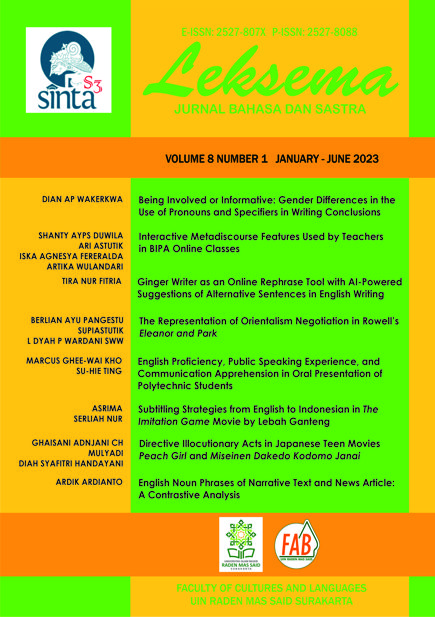DIRECTIVE ILLOCUTIONARY ACTS IN JAPANESE TEEN MOVIES PEACH GIRL AND MISEINEN DAKEDO KODOMO JANAI
DOI:
https://doi.org/10.22515/ljbs.v8i1.6067Keywords:
directive function, illocutionary act, Japanese movie, speech actAbstract
This study aimed to describe the meaning of directive illocutionary speech acts in two Japanese movies entitled Peach Girl and Miseinen Dakedo Kodomo Janai. The directive illocutionary act is the most frequently used speech act in everyday life. In Japanese language, the meanings of these speech acts are often misinterpreted by Japanese language learners, so that the meanings of the speeches are not conveyed properly. In the movies Peach Girl and Miseinen Dakedo Kodomo Janai, the characters use a lot of directive illocutionary speech acts. Therefore, it is worth to conduct a deeper study regarding the meaning of those directive speech acts. This research used speech act theory proposed by Searle (1979) and applied descriptive-qualitative method. The results show that there are 10 meanings of directive illocutionary speech acts with their own structural characteristics, namely command (used in polite language form) order (with V~te form), beg (with the word onegai), request (with V~te form), invitation (with invitation form V~ou), deny (with ~nai form), advise (with V~nda form), prohibition (with V~nai form), warn (with V~te form and particle ~ne), and ask (with keigo form).
Downloads
References
Austin, John Langshaw. 1962. How to Do Things with Words. Oxford: Oxford University Press.
Azhari, Tiara Sabrina. 2021. Tindak Tutur Ilokusi Direktif dalam Anime Sword Art Online Alternative: Gun
Gale Online (Undergraduate Thesis). Jakarta: Universitas Darma Persada.
Cruse, Alan. 2000. Meaning in Language: An Introduction to Semantics and Pragmatics. Oxford: Oxford University Press.
Griffiths, Patrick. 2006. An Introduction to English Semantics and Pragmatics. Edinburgh: Edinburgh University Press.
Hanabusa, Tsutomu 2017. Miseinen Dakedo Kodomo Janai. (Live-Action Movie).
Hidayat, Taufik Rahman and Nova Yulia. 2020. "Tindak Tutur Direktif Bahasa Jepang dalam Dialog Movie Flying Colors (ビリギャル) Karya Sutradara Nobuhiro Doi." Omiyage: Jurnal Bahasa dan Pembelajaran Bahasa Jepang 3 (2): 44-68.
Kokugoshiten Online. 2014. 国語辞典オンライン. https://kokugo.jitenon.jp/word/p6015?getdata=%E3%81%8A%E9%A1%98%E3%81%84&search=contain. Accessed July 4, 2023
Kroeger, Paul R. 2018. Analyzing Meaning: An Introduction to Semantics and Pragmatics. Berlin: Language Science Press.
McCready, Elin and Christopher Davis. 2020. "Sentence-final Particles in Japanese." In Wesley M. Jacobsen and Yukinori Takubo (eds.). Handbook of Japanese Semantics and Pragmatics: 655-686. Berlin: De Gruyter Mouton.
Muslihah. 2017. Tindak Tutur Direktif pada Drama Miss Pilot (Kajian Sosiopragmatik) (Undergraduate Thesis). Semarang: Universitas Diponegoro.
Pratama, Putu Diva Dian, et al. 2022. "Analisis Tindak Tutur Direktif dalam Drama 3 Nen A Gumi Karya Komuro Naoko dan Suzuki." Sakura 4 (2): 156-169.
Raco, Jozef. 2018. Metode Penelitian Kualitatif: Jenis, Karakteristik dan Keunggulannya. Jakarta: PT Gramedia Widiasarana Indonesia.
Rizkianto, Ichsan. 2018. Tindak Tutur Ilokusi Direktif dalam Serial Drama Yorozu Uranaidokoro Onmyouya he Youkoso Karya Sutradara Masato Hijikata. (Undergraduate Thesis). Malang: Universitas Brawijaya.
Sbisa, Maria and Ken Turner. 2013. Pragmatics of Speech Actions. Berlin: De Gruyter Mouton.
Searle, John R. 1979. A Taxonomy of Illocutionary Acts. Minneapolis: University of Minnesota Press.
Shintoku, Kouji. 2017. Peach Girl (Movie). Fine Entertainment.
Yule, George. 1996. Pragmatics. Oxford: Oxford University Press.
Downloads
Published
Issue
Section
License
Copyright (c) 2023 Leksema: Jurnal Bahasa dan Sastra

This work is licensed under a Creative Commons Attribution-NonCommercial-ShareAlike 4.0 International License.
The copyright of the received article shall be assigned to the publisher of the journal. The intended copyright includes the right to publish the article in various forms (including reprints). The journal maintains the publishing rights to published articles.
In line with the license, the authors and users (readers or other researchers) are allowed to share and adapt the material only for non-commercial purposes. In addition, the material must be given appropriate credit, provided with a link to the license, and indicated if changes were made. If authors remix, transform or build upon the material, authors must distribute their contributions under the same license as the original.







